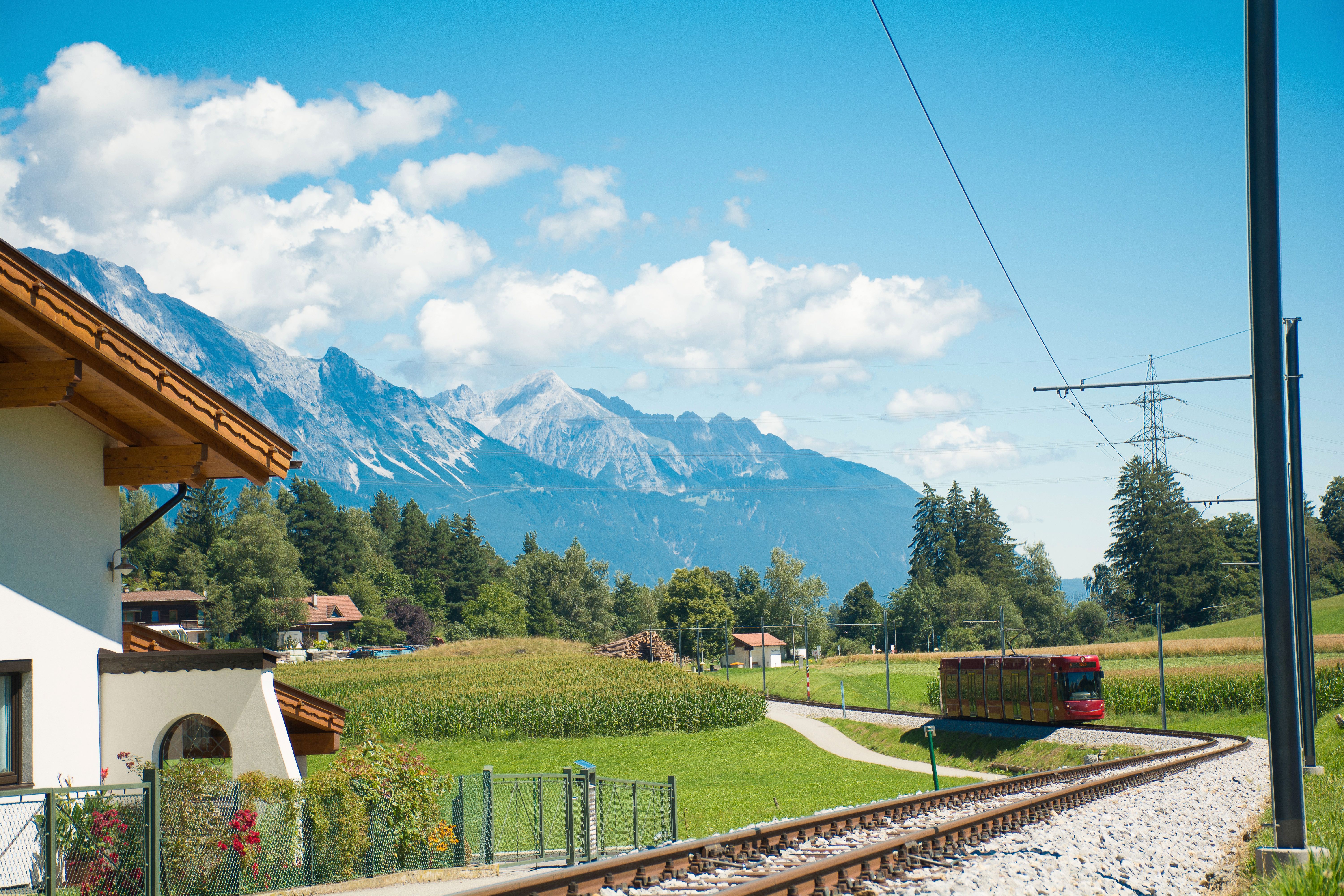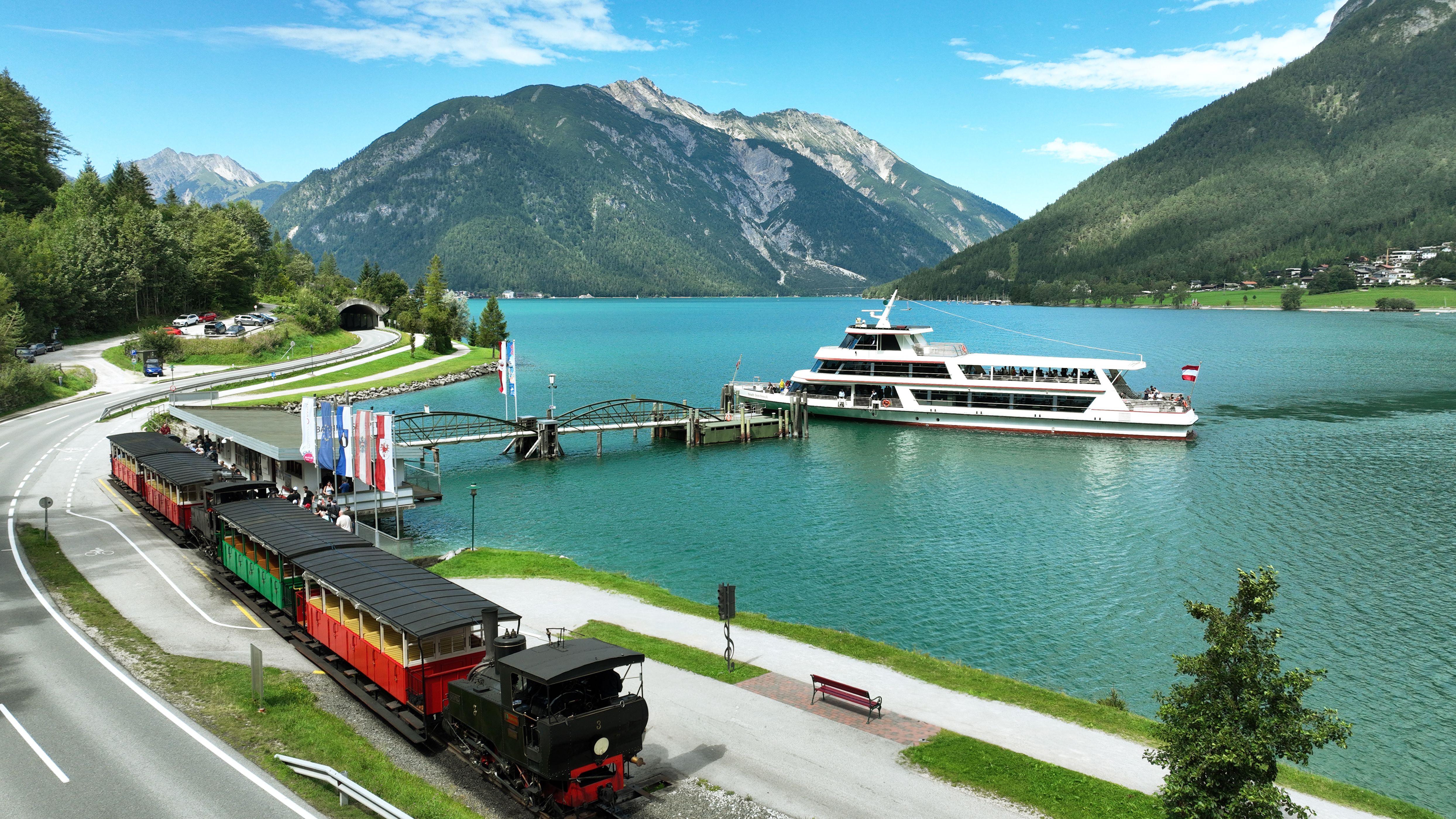
To connect Tirol’s capital Innsbruck and the former climatic health resort Igls, the railroad’s 1900s builders constructed tracks that winded up more than 280 meters in elevation through forest. Tram #6 is aptly named “Forest Streetcar” by locals. From “Bergisel” Stop at Wilten Basilica, take a scenic journey through lush pine forests, past Ambras Castle and up across verdant countryside to Igls. Once up there, you are recommended to take a lovely walk from Igls to Lansersee Lake, where you can refuel at the lakeside restaurant or take a refreshing dip on a hot summer’s day. Get aboard the historic streetcar again at the “Lanser See” Stop, which is within a few minutes’ walk from the lake, and ride back to Innsbruck.
Scenic Highlights: Lansersee Lake (take a walk or a bath); visit Ambras Castle; stroll around Igls
In Innsbruck, climb aboard the Stubaitalbahn, Fulpmes-bound STB Tram for a memorable journey into scenic Stubai Valley. You will leave Tirol’s vibrant capital towards Brenner Pass and soon the tram will start climbing. The grades are severe as is the curvature in places. The line serves small communities in Wipptal Valley, such as Natters and Mutters, before winding into Stubai Valley. En route, it also goes through dense forests and there are several tall curved viaducts. Get your camera ready for breathtaking views of Bergisel Ski Jump, rugged Sillschlucht Canyon, lofty Europabrücke Bridge and gorgeous Serles Peak. Deer and cattle often graze railroad side and are accustomed enough to visitors in the area that they’ll usually lazily stare back at you as you snap a picture. Mountain idyll at its best.
Innsbruck lies at an elevation of 550 meters, Seefeld is situated at 1,200 meters. Thus, the railway connecting Innsbruck and Seefeld has to gain 650 meters of elevation on its 20-kilometer long trip. The most remarkable thing about the route of the Mittenwald Railway is the long section with many tunnels along the edge of the Martinswand (Martin’s Wall), a perpendicular rock face, including the passage of the almost 2-kilometer long Martinswand Tunnel through the rock wall. The spectacular Mittenwaldbahn Railway links Innsbruck to Seefeld and continues to the west over Scharnitz Pass and the Austria-Germany border to Garmisch-Partenkirchen and eventually Munich. It is an exciting experience to ride in a train over such a route. The long climb up to Seefeld in severe grades and 200 meter curvatures, the glimpses of rushing torrents far below, and the frequent viaducts and tunnels—which, save for the darkness and the drip from the roof, are not unpleasant in these days of electric working—combine to make the journey an eventful one. If you want to take a picture of the spectacular view down into the Inntal Valley, you better not hesitate, otherwise you are in the next dark tunnel. Viewing up you will see jagged cliffs and faces, viewing down canyons and ditches. The Mittenwald Railway follows a bold route, planned by pioneering railway engineers and was opened more than 100 years ago. Many commuters take the train from Seefeld to Innsbruck every day, so you will meet and mingle with locals on this adventurous rail trip.
Austria’s highest international border happens also to be the country’s highest paved road open to motorized vehicles. The spectacular serpentine drive reaches the summit of 2,509-meter Timmelsjoch Col (called Passo Rombo in Italian) and connects Ötztal Valley in the Austrian Tirol to Passeier Valley in the Italian Province of South Tyrol. Second only to Col d’Agnel, Timmelsjoch is the second highest international border of Europe. And it is readily accessible by public transportation in the summer. The Timmelsjoch High Alpine Road is a toll road, thus going there by bus saves you the toll fee and you will be whisked up to the mountain without the hassle of driving the serpentines up yourself, giving you time to catch views of glacier-carved valleys, daunting peak summits and distant crystalline lakes. Each year, the Timml, as it is lovingly dubbed by the locals, welcomes thousands of leisure drivers, motorcycle riders, cyclists and all others hungry for a taste of Tirol’s history and scenic beauty. If grandiose nature inspires you, just take a look around! Stop by the Pass Museum atop Timmelsjoch Col for stories of colourful characters and insights into the pass road’s history. A lovely walk in this area is the loop trip to Kummersee Lake, which takes some 3 to 4 hours to complete. The rock cairns atop the col, a short walk from the parking lot, are spectacular and definitely worth visiting to everyone making the journey up here; no sturdy boots are required for this stroll.
Famous for its sharp ridges, jagged peaks and the solitude its rugged terrain offers, the lofty Lechtal Alps create a dramatic setting of unparalleled splendour and beauty. Building a road across this terrain is a challenge, as is road maintenance. The road is normally open by May, but closures are common through summer due to spring snowstorms and heavy thunderstorms. The pass road is prone to avalanches, falling rocks, and mudslides. Nevertheless, the Hahntennjoch Pass Road is an important drive as it connects the upper valley of Inn River with Tirol’s Lechtal Valley during the summer months. The high Alpine road leads from Imst (Inntal) to Elmen (Lechtal) and is popular with motorcyclists and cyclists as well. Plus, there are buses operating along this scenic drive. Coming from Imst, you’ll pass through rugged Salvesental Valley past barren rock, scree and scrub. As you near the top, the scenery turns more and more picturesque and lovely, with Maldon Alpine Pasture Hut and cheese dairy to the right and grazing cattle and amazing wildflower galore as far as the eyes can see. The pass has great access points for hikers, such as the scenic hike to Anhalter Hut. The 1.5-hour walk reveals this otherworldly landscape in all its glory, and the trail leads through flower fields and past thundering waterfalls. This is one of Tirol’s top spots for spring wildflower viewing! From Anhalter Hut, you can either retrace your steps to get back to the pass or walk down to Bschlabs along Plötzigtal Valley, where you can catch a bus to get you back. Bschlabs, Boden and Pfafflar are not words that come easily off the tongue, but in these tiny hamlets of Bschlabertal Valley the wow factor far exceeds the “ow” factor; gorgeous scenery awaits in this remote wilderness and the three chocolate-box villages have no more than 130 residents altogether. The historic wooden homes, which are typical of Pfafflar, are constructed of round tree trunks; some of them date back to the 13th century.
The small town of Jenbach itself is not especially spectacular, but its railroad station is a true gem for railway enthusiasts as it has the proud distinction of having one of the very rare triple gauge tracks in the world. Jenbach is the place where three different carriers using three different traction engines and three different track gauges come together: Achensee Cog Railway with a metre gauge line (1,000 mm), Austrian Railways with standard gauge line (1,435 mm) and Zillertal Train using narrow gauge (760 mm). Thus the running lines here are for standard and two different narrow gauge rolling stock, making Jenbach the perfect place for two truly memorable, historic train ride adventures. Jenbach is as well placed on the international railway network so getting here is easy with regular train services from Innsbruck and from most major European cities.
The Achensee Cog Railway is a 7-kilometer long meter gauge railway running between Jenbach and Seespitz. Within its length, it gains some 440 meters in elevation, with the steeper sections using the Riggenbach rack system. Underneath and between the wheels is a giant gear – a third rail – that is used by the train for traversing steep gradients. It is Europe’s oldest cog railway, which is still steam operated, and continues to provide a sense of adventure and history as it carries passengers from the Railroad Station at Jenbach up the hill to scenic Achensee Lake. Experience the adventure of travelling by a coal-fired, steam-powered locomotive and enjoy Tirol at its best…stunning scenery and majestic peaks, all from the view of a historic 1880s passenger car, called Theodor, Hermann, Georg or Hannah. Relive history with the sights and sounds of yesteryear for a truly spectacular 30-minute journey on board the Achensee Narrow Gauge Cog Railway. Up at Seespitz on the shores of Achensee Lake, you may choose to continue your memorable journey in a boat of Achensee Lake Fleet. If the weather is fine, you are recommended to take the boat to Gaisalm, which is the trailhead for a wonderful, partly rugged and exposed trail that follows the shores of Achensee Lake to Achenkirch. The return trip to Seespitz will be by boat rather than by shoreline. The scenic walk from Gaisalm to Achenkirch takes some 1.5 hours to complete. Those opting for a longer hike should leave the boat at Pertisau and walk to Achenkirch via Gaisalm. The trail linking Pertisau to Gaisalm is less demanding than the one connecting Gaisalm to Achenkirch. The lovely 9-kilometer hike takes some 2.5 to 3 hours to complete (without stopping for lunch at Gaisalm).

The Zillertal Train travels between the towns of Jenbach and Mayrhofen in Zillertal Valley. The line is much appreciated by tourists but is also well used as an ordinary transport method by locals. During the warm summer months (June through October), historic steam-powered locomotives operate with heritage veranda rolling stock for special trains targeting tourists two times a day; in the winter the passenger train services operate using modern diesel locomotives and railcars. The splendour of a bygone era awaits you aboard the Crystal Car, one of the most outstanding cars to ever grace the narrow gauge rails, decorated with thousands of sparkling Swarovski crystals. A wonderful day trip for cyclists is to take a ride on the gorgeous Zillertal Cycle Path. The flat terrain, gentle elevation gain and beautiful scenery make it the ideal option for leisure cyclists and families. Ride the Zillertal Train to Mayrhofen and follow the Ziller River downstream to Strass. If you have the time and energy, you can continue cycling along the Inn Cycle Path to Jenbach. However, the excellently signed Zillertal Cycle Path passes several train stations across Zillertal Valley where you can get aboard historic Zillertal Train to shorten your journey and get back to Jenbach if you wish. The train provides free bicycle transport and cycling equipment is available for rental from all train stations (city bikes, children’s bikes, child seats and helmets).